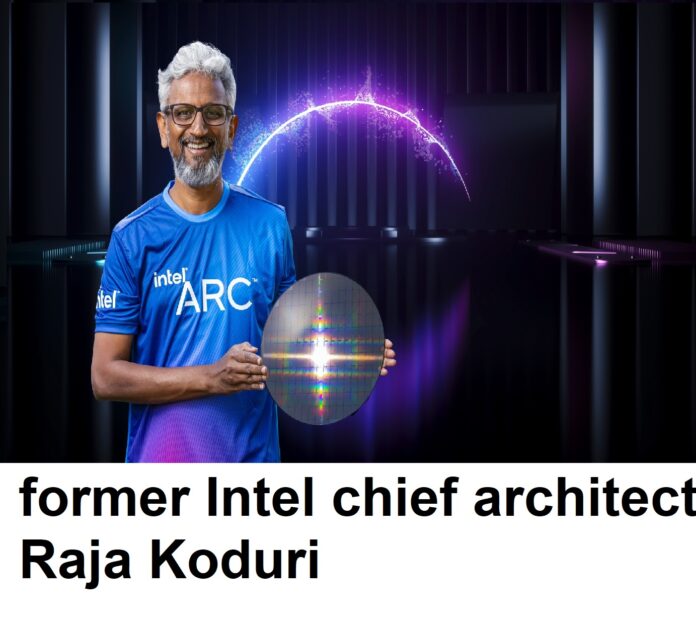Two areas in particular have captured the focus in the rapidly changing world of technology: semiconductor chips and artificial intelligence (AI). Finding someone who can effortlessly move between these two dynamic sectors is uncommon. Such a unique person is Raja Koduri.
Koduri built a successful career as a semiconductor designer before becoming Intel’s chief architect, which was the pinnacle of his journey. But he just started a new chapter by founding the artificial intelligence business Mihira AI. The purpose of Mihira AI goes far beyond traditional chip design; it aims to change a number of industries, including the production of breathtaking visual spectacles in the realm of film.
Koduri had connections to the motion picture business even before he founded Mihira AI. He invested in and advised Makuta, a business that in 2012 won national acclaim for its extraordinary visual effects work in the Telugu fantasy movie “Eega.” It’s interesting to note that SS Rajamouli, the director of “Eega,” won critical accolades for his work on “RRR” last year and is also Koduri’s cousin.
Koduri, however, thinks that the real promise lies outside of the world of film. He plans to build data centers at 100-kilometer intervals to use AI to benefit rural areas of India. This ambitious project aims to promote self-sufficiency in AI development and lessen India’s dependency on Nvidia chips. Insights from a recent interview with Raja Koduri are summarized here:
The Vision of Mihira AI
Koduri’s design for Mihira AI is very revolutionary. He wants to use AI to empower all artists and make them into super-artists. The goal is to teach thousands of artists in India how to use new tools, allowing them to produce visual spectacles on a scale that has never been achieved before. The objective is to create visual marvels comparable to “Game of Thrones” on a budget that is a small portion of what movies like “Avatar” required, which is both ambitious and practical.
Localized Technology Development
The majority of Mihira AI’s personnel will be based in India, while it will be distributed across the world. Koduri plans to build facilities in outlying Indian towns, which will need a substantial investment in data center infrastructure. He thinks that India has to have top-notch computing infrastructure throughout the country in order to become a leader in the field of technology.
The Business Case for Data Centers
The cost of establishing several data centers can appear to be unbeatable. Koduri is optimistic, nevertheless, that India’s manufacturing capabilities may drastically cut prices, perhaps by several billion dollars. He underlines the value of having high expectations in order to spur technical progress, drawing comparisons to the amazing developments in smartphone technology.
Talent Attraction for India
Koduri asserts that luring top-tier semiconductor and AI engineers to India requires more than just financial inducements. He emphasizes the value of creating an enthusiastic ecology that emulates the characteristics of tech hotspots like Silicon Valley. The momentum India is showing in this area is encouraging, and Koduri thinks that India’s chance to shine in the tech world has come.
Moving from IP Development to Services
Koduri thinks that Indian companies should concentrate on creating intellectual property (IP) in order to move beyond being service-centric. This transition calls for a thorough comprehension of end-user requirements and a dedication to resolving their issues. Building products specifically for niche markets, whether they be in gaming, AI, mobile phones, or other industries, is the key.
Investing by angels in chip startups
Koduri is actively interested in providing advice to and perhaps even funding for chip startup companies. He emphasizes that innovation should concentrate on developing goods rather than merely providing services, and he feels that firms like Infinipack have the potential to become global leaders in semiconductor packaging design.
The Prognosis for Moore’s Law
Long-standing in the tech sector, Moore’s Law has changed through time. According to Koduri, the day when chip performance doubled at the same price every two years is over. This trend is seen in the rising cost of smartphones. Although performance may be slightly improved by modern packaging, it won’t be as simple as some presentations might have you believe.
Basic Models for Large Languages
A foundational language model developed for India’s distinct linguistic environment is something Mihira AI is thinking about doing. Koduri stresses that this project, which necessitates significant computer power and monetary expenditure to create, depends on the existence of reliable data center infrastructure.
Infrastructure for GPUs besides Nvidia
Mihira AI is dedicated to developing an infrastructure built on non-Nvidia GPUs such as AMD, Intel, and Tenstorrent since it recognizes the difficulties with Nvidia GPU availability. The objective is to establish intellectual property around these GPUs and optimize them to decrease dependency on a single vendor.
Future Plans and Investments
The platform of Mihira AI is expected to receive investments totaling several hundreds of millions of dollars, with a major chunk of that money going to India. The new business has already obtained enough funding. Koduri also states that he is interested in strategic alliances that can offer useful networks rather than just money.
Beyond Film: The Real Possibilities
Mihira AI works with well-known artists, such as Rajamouli, but its scope goes well beyond the world of film. Koduri thinks that industries like manufacturing, healthcare, and sports offer enormous prospects. He draws attention to the fact that an iPhone launch costs more than many films do. Koduri hopes to effectively instruct India’s enormous labor population by utilizing AI-based virtual reality.
The Future of Employment and AI
Koduri offers his perspective on how AI would affect jobs in his final statement. He sees a time when people will receive virtual assistance for jobs like plumbing and electrical repairs, with expertise in manual labor having genuine worth. He thinks that in the post-AI era, people with soft knowledge may wind up at the bottom of the job ladder, emphasizing the dynamic nature of skills and knowledge.



